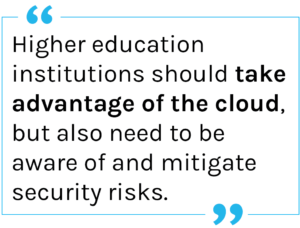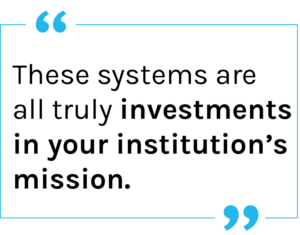Digitization is no longer a luxury for higher education institutions. It’s a necessity.
According to a recent Educause webinar, incoming college students are taking wifi speed and strength into consideration when deciding which school to attend. Job-seekers and employees today expect more access to the data and information they need, wherever and whenever they want. Millennials and Gen Z-ers expect to have the same digital experiences in their workplaces and schools as they do in their personal lives, and many prefer digital communication over face-to-face. As noted by Educause, in order to get this kind of seamless digital experience, information access, and give students, staff, and faculty the ability to do simple things like fill out forms online instead of in-person, data needs to be flowing across campus constantly. Read on to learn how your interconnected systems offer a high return on investment.
which school to attend. Job-seekers and employees today expect more access to the data and information they need, wherever and whenever they want. Millennials and Gen Z-ers expect to have the same digital experiences in their workplaces and schools as they do in their personal lives, and many prefer digital communication over face-to-face. As noted by Educause, in order to get this kind of seamless digital experience, information access, and give students, staff, and faculty the ability to do simple things like fill out forms online instead of in-person, data needs to be flowing across campus constantly. Read on to learn how your interconnected systems offer a high return on investment.
Needs Across Campus
As a PeopleAdmin Product Manager discussed in PeopleAdmin’s recent annual conference, PeopleConnect Live, across campus, different departments and positions face various challenges with technology and digitization. In providing a unified experience for your institution, it’s important to understand the technology needs that faculty, staff, and students need to succeed.
Academic affairs departments are dealing with the once-in-a-lifetime shift to hybrid teaching and learning, attempting to maintain and update processes while making sure that faculty and students are set up for success. Social unrest has also impacted many campuses, and highlighted the importance of making sure that faculty bodies are representative of the student populations they are teaching.
 Over in information technology (IT) departments, the focus is on data privacy and security. Presenters at Educause discussed how higher education institutions should take advantage of the cloud, but also need to be aware of and mitigate security risks for their students, faculty, and staff. IT teams are also always thinking of ways to add new services to support the needs of the campus.
Over in information technology (IT) departments, the focus is on data privacy and security. Presenters at Educause discussed how higher education institutions should take advantage of the cloud, but also need to be aware of and mitigate security risks for their students, faculty, and staff. IT teams are also always thinking of ways to add new services to support the needs of the campus.
In human resources departments, challenges include facing the great resignation, winning the war for talent, shifting practices to respond to employee desires for remote and hybrid work, and embracing technology to further diversity, equity, and inclusion (DE&I) initiatives.
A Connected Campus
The thread that underlies all of these challenges is the need for technology and digitization. Your institution can offer solutions for every corner of campus—but if those solutions don’t connect, you’ll be adding other challenges. Disconnected systems cause countless problems in businesses and HigherEd institutions, including duplicate data entry (which often leads to errors), buried information, inaccurate reporting, increased training costs on multiple complex systems, and costly upgrades and maintenance. When systems aren’t speaking to each other, every department has increased administrative burden and you’re unable to make strategic data connections—like tracking the connection between faculty activity and student outcomes.
With the right interconnected system, your institution can support academic affairs, IT, HR, and your faculty body, all while having a positive impact on the flow of data through student life. There are some key factors that bring a true return on investment (ROI) when you employ solutions.
For IT, a core aspect of data security and privacy is a trusted vendor, along with campus-wide systems for sign-ons and multi-factor authentication, all of which are made easier with interconnected systems.
For human resources departments, the ROI comes from time saved on applicant tracking, repetitive administrative work, and complex onboarding processes. When these tasks are handled by technology, with information that connects to the rest of the employee lifecycle, HR offices can focus on finding the right candidates, interviewing, and other strategic work that leads to making the best long-term hiring choices for your campus.
In academic affairs, administrative processes that share data and faculty-friendly information systems and teaching tools are vital to dealing with the shift to hybrid work as well as the push for digitization. Faculty need to access their information and their course tools wherever they are teaching from, and they are busier than ever. Faster activity reporting helps faculty better balance their time—with a software that offers real-time integrations with ORCiD, faculty can automatically bring over CVs and accomplishments to ensure their data is always accurate and up-to-date. With the right integrations, institutions can also gain access to insights that will help optimize curriculum and positively impact student outcomes. Institutions moving towards more streamlined tenure and promotion review processes will see time savings for academic affairs and faculty, and the right platform will offer opportunities to spot implicit bias and understand D&I metrics.
These systems are all truly investments in your institution’s mission: in the faculty who provide knowledge, research, and mentoring, and in the students who come to colleges and universities to learn and grow. The ROI is clear: when you enable your campus to work together with interconnected systems, when you make your faculty’s jobs easier, and when you give students access to seamless digital experiences, you are taking your institution to a new level. This also highlights the importance of having not just interconnected systems, but HigherEd-specific systems with customizable workflows that are built around your institution’s focus on faculty, students, and the higher education mission.
the students who come to colleges and universities to learn and grow. The ROI is clear: when you enable your campus to work together with interconnected systems, when you make your faculty’s jobs easier, and when you give students access to seamless digital experiences, you are taking your institution to a new level. This also highlights the importance of having not just interconnected systems, but HigherEd-specific systems with customizable workflows that are built around your institution’s focus on faculty, students, and the higher education mission.
Final Thoughts

When taking a look at your institution’s digital transformation, be sure to examine the ways your tech will work together. The ROI of systems that communicate and work in concert is huge for a higher education institution and an important factor for ensuring the success of your staff, faculty, and students. Consider security, higher education-specific programs, and systems that can be built on when looking at building or upgrading your technology.